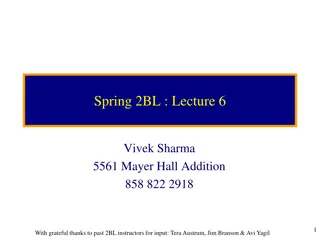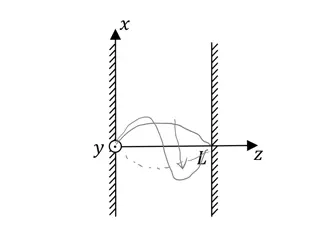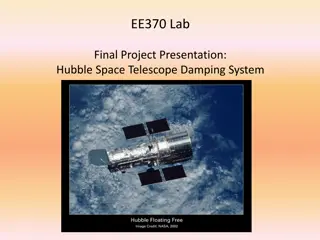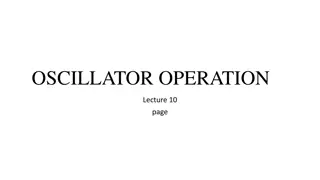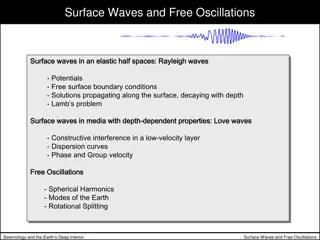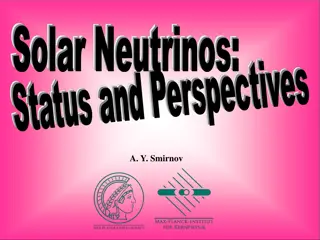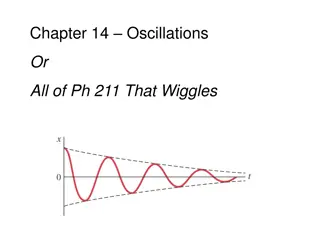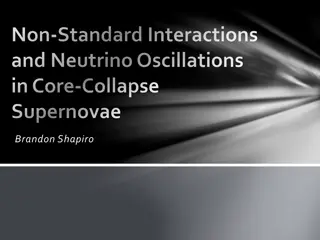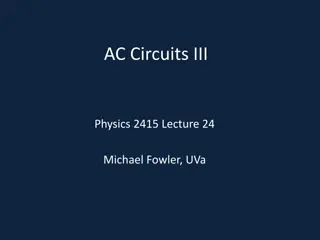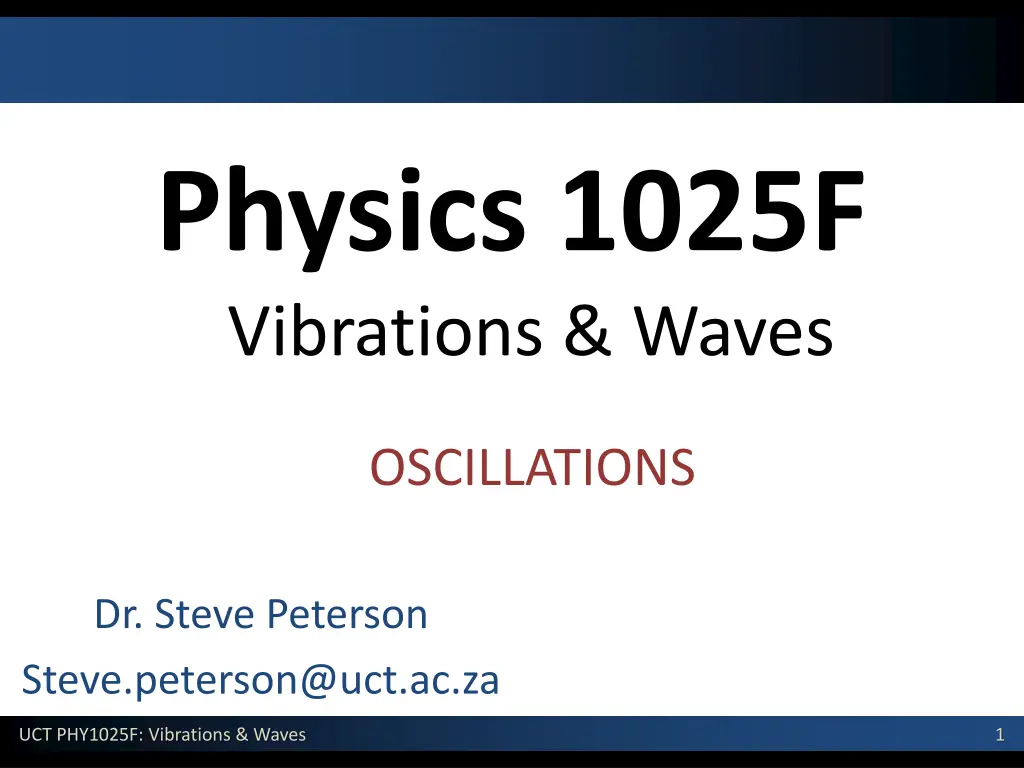
Understanding Vibrations and Waves in Physics
Explore the concept of periodic motion, equilibrium, oscillation, and simple harmonic motion (SHM) in Physics, focusing on the essential principles of vibrations and waves. Learn about Hooke's Law and the characteristics of SHM with examples like the horizontal mass-spring system.
Download Presentation

Please find below an Image/Link to download the presentation.
The content on the website is provided AS IS for your information and personal use only. It may not be sold, licensed, or shared on other websites without obtaining consent from the author. If you encounter any issues during the download, it is possible that the publisher has removed the file from their server.
You are allowed to download the files provided on this website for personal or commercial use, subject to the condition that they are used lawfully. All files are the property of their respective owners.
The content on the website is provided AS IS for your information and personal use only. It may not be sold, licensed, or shared on other websites without obtaining consent from the author.
E N D
Presentation Transcript
Physics 1025F Vibrations & Waves OSCILLATIONS Dr. Steve Peterson Steve.peterson@uct.ac.za UCT PHY1025F: Vibrations & Waves 1
Chapter 11: Vibrations and Waves Periodic motion occurs when an object vibrates or oscillates back and forth over the same path UCT PHY1025F: Vibrations & Waves 2
Periodic Motion Periodic motion, processes that repeat, is one of the important kinds of behaviours in Physics UCT PHY1025F: Vibrations & Waves 3
Equilibrium and Oscillation Equilibrium position position where net force is zero Restoring force force acting to restore equilibrium Oscillation periodic motion governed by a restoring force UCT PHY1025F: Vibrations & Waves 4
Equilibrium and Oscillation A graph or motion that has the form of a sine or cosine function is called sinusoidal. A sinusoidal oscillation is called simple harmonic motion (SHM) UCT PHY1025F: Vibrations & Waves 5
Simple Harmonic Motion SHM is characterised by Amplitude A: maximum distance of object from equilibrium position Period T: time it takes for object to complete one complete cycle of motion; e.g. from x = A to x = A and back to x = A Frequency : number of complete cycles or vibrations per unit time ? =1 Displacement x: is the distance measured from the equilibrium point ? UCT PHY1025F: Vibrations & Waves 6
Simple Harmonic Motion SHM occurs whenever the net force along direction of 1D motion obeys Hooke s Law - (i.e. force proportional to displacement and always directed towards equilibrium position) Not all periodic motion over the same path can be classified as SHM Initially, we will look at the horizontal mass-spring system as a representative example of SHM UCT PHY1025F: Vibrations & Waves 7
Hookes Law Review = sF kx k is the spring force spring constant x is the displacement of the mass m from its equilibrium position (x = 0 at the equilibrium position) The negative sign indicates that the force is always directed opposite to displacement (i.e. restoring force towards equilibrium) UCT PHY1025F: Vibrations & Waves 8
Example: Hookes Law A prosthetic leg contains a spring to absorb shock as the person is walking. If an 80 kg man compresses the spring by 5 mm when standing with his full weight on the prosthetic, what is the spring constant (k)? How far would the spring compress for a 100 kg man? UCT PHY1025F: Vibrations & Waves 9
Horizontal Mass on a Spring From Newton II, for a mass-spring system: = = F kx ma net k m = a x For a horizontal mass-spring system & all other cases of SHM, acceleration depends on position Since acceleration is not constant in SHM standard equations of motion cannot be applied UCT PHY1025F: Vibrations & Waves 10
Example: SHM V&S Example 13.2: A 0.350-kg object attached to a spring of force constant 1.30 x 102 N/m is free to move on a frictionless horizontal surface. If the object is released from rest at x = 0.10 m, find the force on it and its acceleration at x = 0.10 m, x = 0.05 m, x = 0 m, x = -0.05 m, and x = -0.10 m. UCT PHY1025F: Vibrations & Waves 11
The Simple Pendulum SHM occurs whenever the net force along direction of 1D motion obeys Hooke s Law For a pendulum, the restoring force is = sin Fnet mg Does this motion qualify as simple harmonic motion? A. Yes B. No UCT PHY1025F: Vibrations & Waves 12
The Simple Pendulum A pendulum only exhibits SHM if it is restricted to small-angle oscillations (< 10 ). For such small angles (in radians), we get the small-angle approximation, where sin UCT PHY1025F: Vibrations & Waves 13
The Simple Pendulum Using the small-angle approximation, the restoring force becomes mg Fnet = sin mg The pendulum displacement (the arclength s) is proportional to the angle giving s mg Fnet = s = L mg = s L L Linear restoring force UCT PHY1025F: Vibrations & Waves 14
Energy in a Mass-Spring System The potential energy of a spring (Section 6-4): The kinetic energy of the mass (Section 6-3): Therefore the total energy of the spring-mass system is: This total energy is conserved(assuming no friction, etc ) UCT PHY1025F: Vibrations & Waves 15
Energy in Simple Harmonic Motion Energy is all PE when ? = ? Total energy is Energy is all KE when ? = ? Total energy is conserved, so UCT PHY1025F: Vibrations & Waves 16
Example: Energy of Spring A 4.0 kg mass attached to a horizontal spring with stiffness 400 N/m is executing simple harmonic motion. When the object is 0.1 m from equilibrium position it moves with 2.0 m/s. Calculate the amplitude of the oscillation Calculate the maximum velocity of the oscillation UCT PHY1025F: Vibrations & Waves 17
Energy in Simple Harmonic Motion Conservation of energy allows the calculation of the velocity of an object attached to a spring at any position in its motion: UCT PHY1025F: Vibrations & Waves 18
SHM and Uniform Circular Motion The velocity of the rotating object is equal to the maximum velocity of the object in SHM. The circle circumference is 2?? and the rotation time is ?, thus ????=2?? ? From energy, we have: ????= Combining them gives: = 2??? ? ?? ? ? OR ? = 1 ? ? ? = 2? 2? UCT PHY1025F: Vibrations & Waves 19
Simple Harmonic Motion The position, velocity and acceleration are all sinusoidal The frequency does not depend on the amplitude The object s motion can be written as 2 T t = ( ) y t cos A 2 T t = ( ) sin v t max v y 2 T t = ( ) cos a t a max y UCT PHY1025F: Vibrations & Waves 20
Example: SHM Giancoli Example 11-7: The displacement of an object is described by the following equation, where x is in meters and t is in seconds: ? = 0.30 m cos 8.0? . Determine the oscillating object s (a) amplitude, (b) frequency, (c) period, (d) maximum speed, and (e) maximum acceleration. UCT PHY1025F: Vibrations & Waves 21
The Simple Pendulum (Review) Using the small-angle approximation, the restoring force becomes mg Fnet = sin mg The pendulum displacement (the arclength s) is proportional to the angle ? = ?? giving s mg Fnet = mg = s L L UCT PHY1025F: Vibrations & Waves 22
Frequency of Simple Pendulum Simple harmonic motion is based on the restoring force obeying Hooke s Law, so let s compare the pendulum force to Hooke s law. = mg L = F kx F s net net If we take ? =?? equation becomes: ?, then our frequency 1 1 k m g L = = f f L g 2 2 = 2 T And the period equation becomes: UCT PHY1025F: Vibrations & Waves 23
Frequency and Period Two observations: The frequency and period of oscillation depend on physical properties of the oscillator. Spring: Mass & Spring Constant Pendulum: Length They do not depend on the amplitude of the oscillation. Pendulum frequency does not depend on mass The pendulum depends only on ? and ? making it a useful timing device UCT PHY1025F: Vibrations & Waves 24
Damping & Resonance Damped harmonic motion happens when energy is removed (by friction, or design) from the oscillating system. Resonance occurs when energy is added to an oscillator at the natural frequency of the oscillator. UCT PHY1025F: Vibrations & Waves 25
Natural Frequency All systems have a natural frequency, the frequency at which a system will oscillate if left by itself. UCT PHY1025F: Vibrations & Waves 26
Resonance Resonance occurs when energy is added to an oscillator at the natural frequency of the oscillator. If an external force of this frequency is applied, the resulting SHM has huge amplitude! UCT PHY1025F: Vibrations & Waves 27
The Wave Model The basic properties of waves (the wave model) cover aspects of wave behaviour common to all waves. A wave is the motion of a disturbance. Waves carry energy & momentum without the physical transfer of material. A traveling wave is an organized disturbance with a well- defined wave speed. UCT PHY1025F: Vibrations & Waves 28
Two Types of Waves: Mechanical Mechanical Waves require some source of disturbance and a medium that can be disturbed with some physical connection or mechanism through which adjacent portions can influence each other (e.g. waves on a string, sound, water waves) UCT PHY1025F: Vibrations & Waves 29
Two Types of Waves: Electromagnetic Electromagnetic Waves ... don t require a medium and can travel in a vacuum (e.g. visible light, x-rays etc) UCT PHY1025F: Vibrations & Waves 30
Making a wave A wave pulse can be created with a single snap on a rope Energy is transmitted from one point on the rope to the next A periodic (continuous) wave can be created by wiggling the rope up and down continuously Energy is continuously being transmitted along the rope UCT PHY1025F: Vibrations & Waves 31
Types of Mechanical Travelling Waves Transverse waves: In a transverse wave, each element that is disturbed moves in a direction perpendicular to the wave motion. Longitudinal waves: In a longitudinal wave, the elements of the medium undergo displacements parallel to the motion of the wave. A longitudinal wave is also called a compression wave. UCT PHY1025F: Vibrations & Waves 32
Some definitions crests and troughs are the high and low points of a wave amplitude, ?,is the height of a crest (depth of a trough) wavelength, ?, is the distance between crests (troughs) frequency, ?, is the number of cycles per unit time period, ?, is the length of a cycle wave velocity, ?, is the velocity the wave crest travels ? =? ?= ?? UCT PHY1025F: Vibrations & Waves 33
Waves on a String and in Air Waves on a string (transverse waves) are propagated by the difference in directions of the tensions. Sounds waves (longitudinal waves) are pressure waves. UCT PHY1025F: Vibrations & Waves 34
Wave Speed: String Both waves on a string and sound waves require a medium and the properties of the medium determine the speed of the wave. For wave on a string, the speed is given by: where ?? is the tension in the string and ? is the linear mass density: ? = sT = v ? ? Observations: - Wave speed increases with increasing tension - Wave speed decreases with increasing linear density UCT PHY1025F: Vibrations & Waves 35
The Principle of Superposition Two travelling waves can meet and pass through each other without being destroyed or even altered. Principle of Superposition - when two waves pass through the same point, the displacement is the sum of the individual displacements Pulses are unchanged after the interference. UCT PHY1025F: Vibrations & Waves 36
Constructive Interference Constructive: Two waves, 1 and 2, have the same frequency and amplitude and are in phase. The combined wave, 3, has the same frequency but a greater amplitude. UCT PHY1025F: Vibrations & Waves 37
Destructive Interference Destructive: Two waves, 1 and 2, have the same amplitude and frequency but one is inverted relative to the other (i.e. they are 180 out of phase ) When they combine, the waveforms cancel. UCT PHY1025F: Vibrations & Waves 38
Wave Pulse Reflection Just like light reflects off water or an echo bounces off a cliff, a wave pulse on a string will reflect at a boundary. Whenever a traveling pulse reaches a boundary, some or all of the pulse is reflected. There are two types of boundaries: - Fixed end - Loose end UCT PHY1025F: Vibrations & Waves 39
Reflection of Pulses Fixed End When a pulse is reflected from a fixed end, the pulse is inverted, but the shape and amplitude remains the same. Think about Newton s 3rd law at the boundary point. UCT PHY1025F: Vibrations & Waves 40
Reflection of Pulses Free End When reflected from a free end, the pulse is not inverted, again the shape and amplitude remains the same. Think about Newton s 3rd law at the boundary point. UCT PHY1025F: Vibrations & Waves 41
Pulse Refection at a Discontinuity A discontinuity can act like a fixed or a free end depending on how the medium changes. Low to high linear mass density acts like fixed end High to low linear mass density acts like free end UCT PHY1025F: Vibrations & Waves 42
Standing Waves When a travelling wave reflects back on itself, it creates travelling waves in both directions. The wave and its reflection interfere according to the Principle of Superposition. The wave appears to stand still, producing a standing wave. UCT PHY1025F: Vibrations & Waves 43
Standing Waves on a String A simple example of a standing wave is a wave on a string, like you will see in Vibrating String practical. The mechanical oscillator creates a traveling wave that is reflected off the fixed end and interferes with itself. The result is a series of nodes and antinodes, with the exact number depending on the oscillating frequency. UCT PHY1025F: Vibrations & Waves 44
Standing Waves on a String Nodes are points where the amplitude is 0. (destructive interference) Anti-nodes are points where the amplitude is maximum. (constructive interference) Distance between two successive nodes is . UCT PHY1025F: Vibrations & Waves 45
Standing Waves on a String The figure shows the n = 2 standing wave mode. The red arrows indicate the direction of motion of the parts of the string. All points on the string oscillate together vertically with the same frequency, but different points have different amplitudes of motion. UCT PHY1025F: Vibrations & Waves 46
Standing Wave on a String There are restrictions to a standing wave on a string. 1. Two ends of the string are fixed, so ? = 0 and ? = ? must be nodes. 2. Standing waves spacing is between nodes, so the nodes must be equally spaced. ? 2 As a result, standing waves will only form at particular modes, which have numbers, i.e. ? = 1, ? = 2, etc. UCT PHY1025F: Vibrations & Waves 47
Standing Wave on a String Each mode has a specific wavelength. For ? = 1, the wavelength is: ?1= 2?. In general, the wavelength for a standing wave on a string is: ??=?? ? for ? = 1,2,3,4, Note: The mode number (?) is equal to the number of anti- nodes. UCT PHY1025F: Vibrations & Waves 48
Standing Wave on a String The standing wave on a string can exist only if it has one of these wavelengths: ??= 2? ?. We can also calculate the frequency of the standing wave: ? ?? for ? = 1,2,3,4, ? ? 2? ??= = 2? ?= ? UCT PHY1025F: Vibrations & Waves 49
Standing Wave on a String ? 2?. The first mode is called the fundamental frequency: ?1= All other modes have a frequency that are multiples of this fundamental frequency: ??= ??1. The fundamental frequency (?1) is known as the first harmonic, ?2 is the second harmonic, ?3 is the third harmonic, etc UCT PHY1025F: Vibrations & Waves 50

